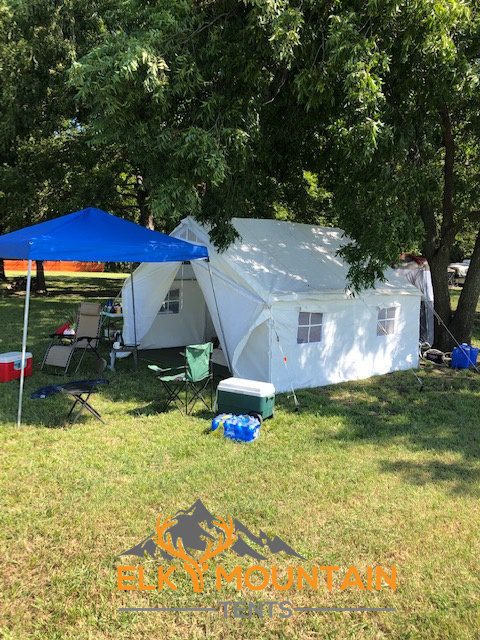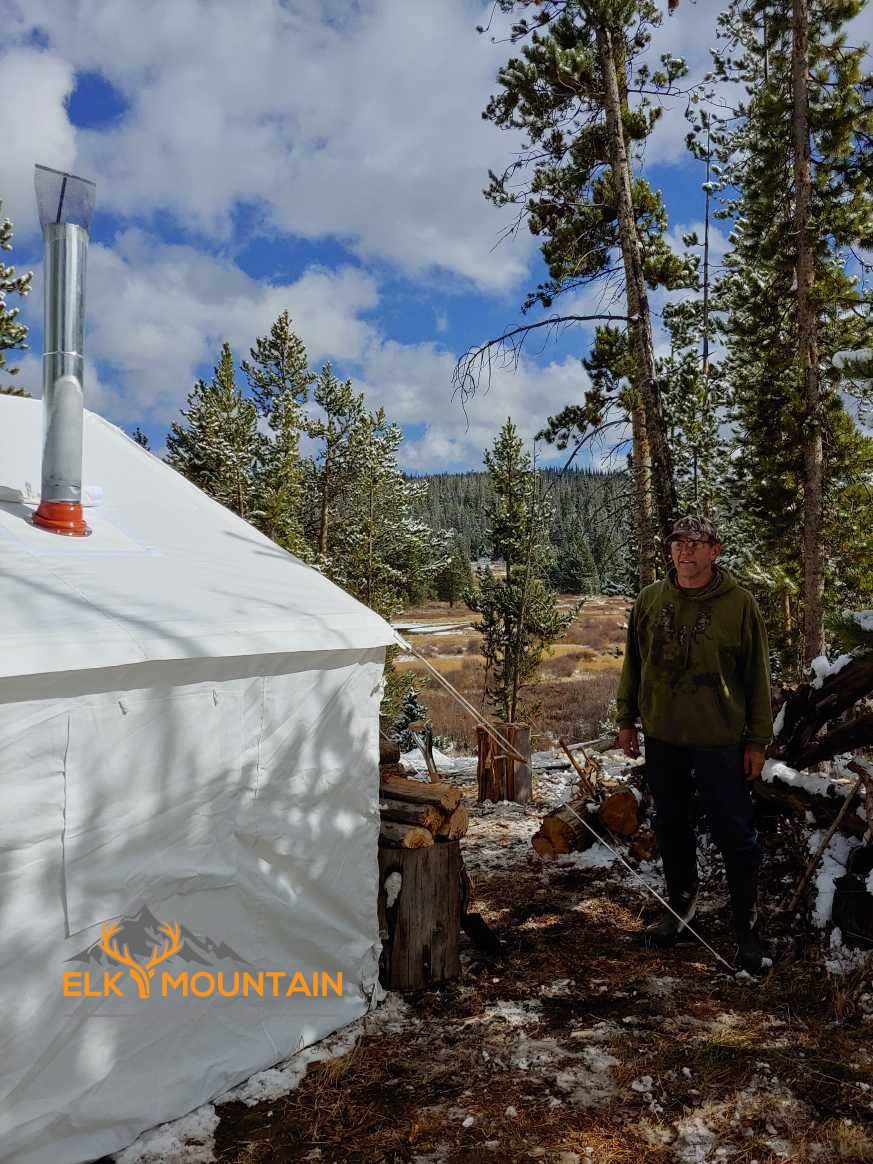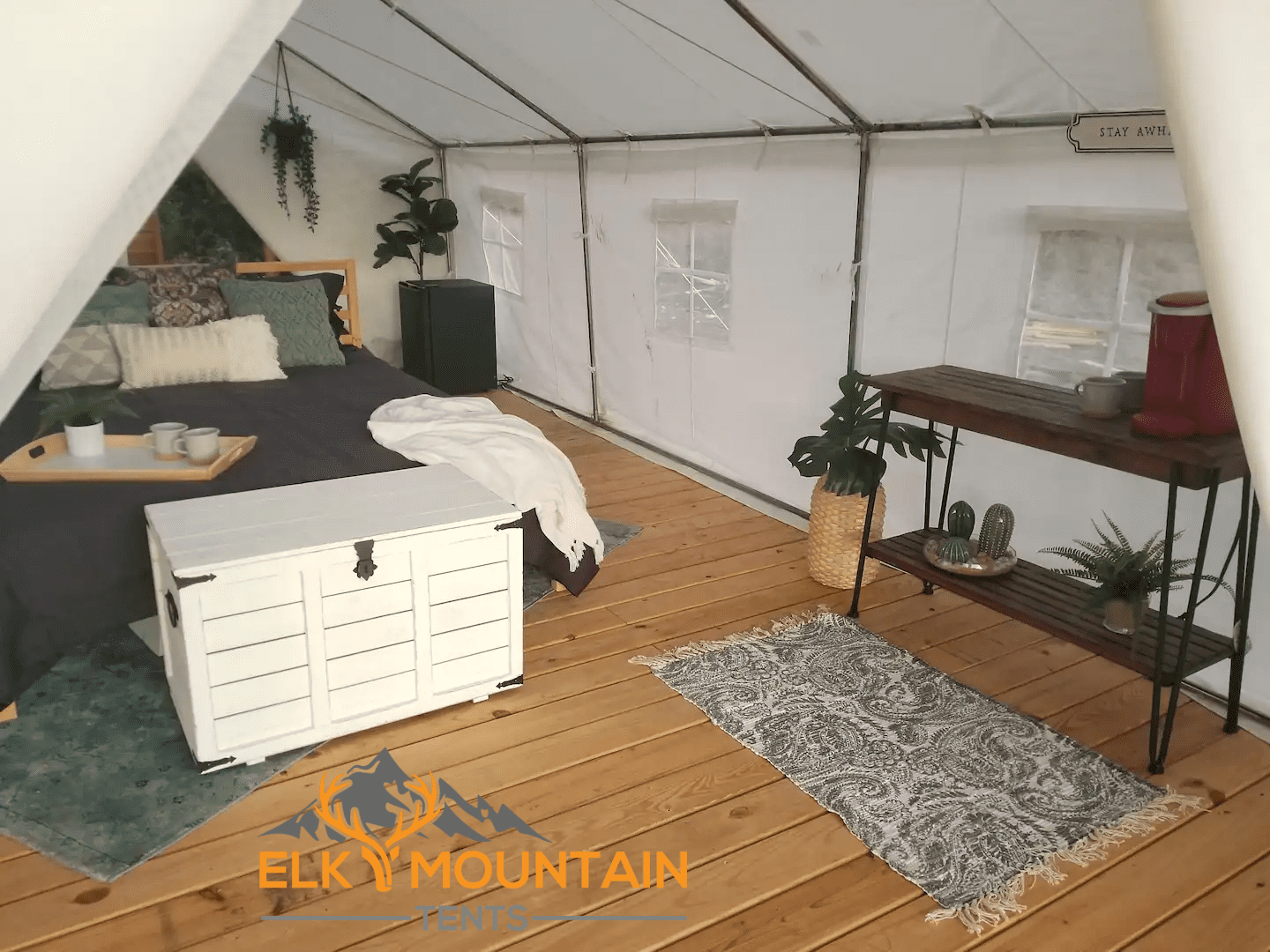 Wood Stove Safety
Wood Stove Safety
Many people don’t consider camping to be a winter activity, and it’s hard to blame them because the cold can make the great outdoors quite miserable. However, there are plenty of reasons to go camping during the colder months of the year (such as hunting) and there are many ways to make winter camping a much more relaxing and enjoyable experience. One of the best things you can do is purchase a tent that is great at keeping heat inside, can endure snow and rough weather, and has a stove jack. A stove jack is a hole that you can put a stove pipe through, allowing you to use a wood stove inside of your tent safely without worrying about overheating and fires. It provides a secure way for harmful fumes and smoke to exit the tent rather than building up inside. There are many great options for strong, durable, tents with stove jacks, including both the canvas wall tent and Yukon bell tent available from Elk Mountain Tents. Some tents even have two stove jacks, usually one in the wall and one in the ceiling, so you can put the stove in the place that works best for your arrangement inside the tent.
There are plenty of advantages to your tent having a wood stove, especially in winter. With a wood stove, you can not only have a much warmer and more comfortable night of sleep, but you can easily heat water for chocolate or coffee in the morning. Get a wood stove and you might find camping to be your new favorite winter activity, or you can turn a good hunting trip into a great one.
What to Consider When Using a Wood Stove in Your Tent
However, there are several things you need to consider when camping with a wood stove in your tent. Chief among these, just like with any other stove, is proper safety precautions. Make sure you are doing all the necessary things to keep yourself and those with you safe. When you do this, you will be able to avoid problems with overheating, injuries, melting, and burning.

The first step you need to take is to make sure there is a fire-retardant lining on the inside of your stove jack. This is usually made of either strong rubber or silicone fiberglass. Stove jacks need to be a safe exit point for fumes that is sure to be protected against fire, or you could end up burning the tent. As long as the stove jack is built to withstand high temperatures, you can safely assume that your tent material will be protected. If you are using a stove jack you purchased, you should be safe, but if you are making your own, make sure you make it from the right material.
The next step is to use the stove for the first time outside before bringing it inside the tent. Many stove manufacturers coat their products with rust-resistant chemicals, which helps the stoves last a lot longer, but it can also give off toxic smells. Using the stove outside the tent first can burn these smells away in a safer environment before you are in an enclosed space with it.
Many stove jacks include a storm flap, a convenient way to cover the hole when not in use. Make sure you take proper caution with this flap, by folding or rolling it safely away from the pipe, as a storm flap can catch fire if it contacts the pipe, which can then spread onto the tent itself.
If you happen to be installing your own stove jack, make it as small as possible while still offering enough room for your stove. This keeps rain and snow from leaking inside, and when too much gets inside it can cause problems for your stove. The stove jack included in Elk Mountain’s canvas wall tent and Yukon Bell Tent allows you to cut the hole to be 4, 5, or 6 inches, according to your individual needs.
Pay extra attention to the guy lines of the tent when you have a wood stove inside, keeping them tight and secure enough to where the tent won’t move around. If these aren’t secure and the tent starts moving, it can allow heavy winds to blow smoke and ashes back into the tent rather than away from it.

Something to consider when installing your own jack is the material of your tent. You should typically only put a stove jack in a tent when it is made of canvas since most other materials are not as capable of withstanding sparks and could catch on fire. If you are trying to figure out where to place the stove jack in your tent, your best bet is to place it above the ridge of the tent. This decreases the chance of sparks catching on the tent’s body by allowing the wind to blow them away from any direction.
Before going out and buying one, it is important to know that there are different kinds of stove jacks, and each kind is a bit different in how it is attached to the tent. Soft stove jacks are either attached to the tent with Velcro or can be sewn in. Usually, these will come with a storm flap that can cover the hole when it’s raining or can be rolled back when you put the pipe through. Rubber and steel stove jacks are attached to the tent on the inside as well as the outside with screws, with the rubber part being on the outside. After it is in place, you can cut a hole in the fabric and feed the pipe through the inside to push the jack outwards, preventing dips from forming in the material.
There are plenty of other things that can help you reduce the chance of anything bad happening while camping with a wood stove. One thing you can do is place a fireproof mat in the tent underneath the stove. You should especially consider this if your floor is made of wood, carpet, grass, or vinyl. Because of sparks that could fly out of the stove (especially when opening the door), it is a good idea to keep anything flammable at least 2 ft. away from it. Combustible items that you are likely to have with you like bug spray and other aerosols need to be kept far away from the stove. Take good care to keep the stove and the spark arrestor inside clean, giving you more control over the fire and preventing excess smoke from building up in the tent.
Cleaning the spark arrestor every 1-2 days (depending on how often you use the stove) will also help to keep smoke out of the tent. Allow the stove to burn for at least one hour each day that you are using it, which keeps ash from building up and therefore regulates the temperature. Too much ash or creosote building up also can also cause much hotter fires than desired, making flames come out of the pipe or even causing smoke to accumulate inside the tent rather than through the pipe. When maintaining the fire in the stove, keep the wood and fire at the back, directed toward the pipe, where smoke can easily enter the pipe and leave the tent. While one advantage of having a wood stove is the ability to cook inside your tent, make sure you only cook meals that can be rehydrated in boiling water (like freeze-dried and dehydrated meals). This is because cooking in an enclosed space causes the smell to linger for quite a while, so cooking fish or meat with your wood stove could attract animals. If you do plan on cooking meat while camping, you should probably cook it over a fire outside.

Another thing you should always do is make sure you have all the proper gear with you. This includes heat-resistant gloves for handling the stove and a fire extinguisher in case of emergency (though don’t keep the fire extinguisher too close to the stove). You may also consider having a carbon monoxide detector, helping you make sure the air inside of the tent is always safe and know if you’ve cleaned the stove properly.
There is a lot you can do when you have a wood stove with you on a winter campout. You can keep warm any time of day or night, you can heat water to use for coffee, hot chocolate, or even a hot meal, and much more. It can change the way you go camping, and you may decide to break your tent out a lot more during months outside of summer. Remember though that it is important to keep yourself and others safe when you do go camping. Take all of the precautions listed here when installing the stove jack in your tent and each time you go for a trip. Clean your stove often, keep flammable and combustible things away from it, and keep rain and snow from leaking inside, and you are ready for the most relaxing and comfortable experience you can have in the great outdoors!
Sources:
https://thetenthub.com/camping-tents/tent-with-stove-jack/
https://www.walltentshop.com/blogs/news/5-tent-stove-safety-precaution-tips

